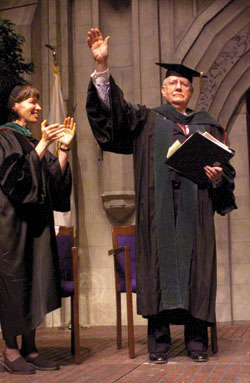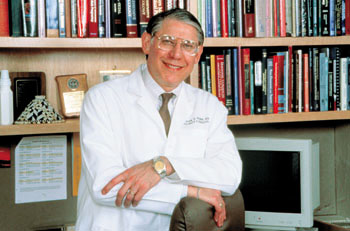
Dr. John E. Chapman waves to the audience during a standing ovation at this year’s graduation.

Groundbreaking of new Children’s Hospital in May.

Dr. Steven Gabbe will assume the role of Dean of Students in March.
As 2000 draws to a close, the staff of The Reporter examined the top stories of the year. The stories are recapped in no particular order.
Chapman graduates
last student
Dr. Charles Jackson Wray became the 3,317th – and last – medical student to be graduated by Dean John E. Chapman.
Chapman announced last year that he would be leaving his post as dean to assume the post of associate vice chancellor for Medical Alumni Affairs once a new dean was named.
Sixty-seven percent of all living VUSM graduates have received their degrees from Chapman since he became dean in 1975. As he completes his 25th year, the average tenure of a medical school dean at the other 124 medical schools in the nation is five years.
Gabbe named Dean of Medical School
Dr. Steven G. Gabbe, one of the most respected academic perinatologists in the United States and a member of the Institute of Medicine, was named Dean of the Vanderbilt University School of Medicine.
Gabbe, currently professor and chairman of the Department of Obstetrics and Gynecology at the University of Washington Medical Center in Seattle, will assume the position in March.
Gabbe replaces Dean John E. Chapman, who has graduated 3,317 medical students (nearly two-thirds of the living graduates) during his tenure as dean over the past 25 years. Chapman announced last year that he would leave the dean’s post to assume the post of associate vice chancellor for Medical Alumni Affairs once a new dean was named.
P&G donation
Procter & Gamble donated its proprietary “COX-2 Inhibitor Technology” – 196 patents and all associated intellectual property for compounds that block the action of the enzyme cyclooxygenase-2.
Two prescription COX-2 inhibitors, Celebrex and Vioxx, have already generated excitement as stomach-friendly treatments for arthritis. And the promise of these drugs doesn’t end with pain and inflammation relief. COX-2 inhibitors may also find use in the prevention and treatment of cancer and Alzheimer’s disease.
The global market for Celebrex and Vioxx is approximately $3 billion annually. If Vanderbilt succeeds in developing and commercializing a new “super aspirin” drug, future royalties could reach a billion dollars annually.
The gift of patent rights to the COX-2 inhibitors was the sixth in a series of Procter & Gamble technology donations to leading universities and research institutions.
Stead joins Institute of Medicine
Dr. William W. Stead was elected into the National Institute of Medicine of the National Academy of Sciences.
Stead is associate vice-chancellor for Health Affairs, professor of Medicine and of Biomedical Informatics, assistant to the chancellor for Informatics and chief information architect for Vanderbilt University.
He joined the elite list of 613 active members of the Institute, and has the privilege to serve with his father, Dr. Eugene A. Stead Jr., who was a charter member of the organization.
Stead became the sixth Vanderbilt faculty member to be elected to the Institute. Others are James Blumstein, professor of law and director of the Center for Health Policy Studies; Dr. John A. Oates, Thomas R. Frist Professor of Medicine; Dr. Mildred T. Stahlman, professor of Pediatrics and Pathology; Brigid L. M. Hogan, Hortense B. Ingram Professor of Molecular Oncology; and Colleen Conway-Welch, dean of the School of Nursing.
Work on new Children’s Hospital begins
An enthusiastic blend of children and their parents, Vanderbilt University faculty and staff, and community leaders joined together to break ground on Vanderbilt University Medical Center’s largest construction project to date – a free-standing children’s hospital, designed to be one of the most family-centered in the country.
The Monroe Carell Jr. Children’s Hospital at Vanderbilt was named after Monroe J. Carell Jr., chairman and chief executive officer of Central Parking Corporation. Carell and his wife, Ann, are leading the fundraising effort for the new hospital.
The $150 million facility is expected to be completed in 2003. The 565,000 square-foot building, designed by Nashville’s Earl Swensson Associates, will consist of nine floors and 206 inpatient beds. It will replace the current hospital, housed on three floors within Vanderbilt.
Beauchamp new Surgical head
Dr. R. Daniel Beauchamp, John L. Sawyers Chair in Surgery, was named director of the Section of Surgical Sciences.
Beauchamp succeeds Dr. James A. O’Neill Jr., John Clinton Foshee Distinguished Chair in Surgery, who is retiring as head of the section. The transition will become official June 30, 2001.
Beauchamp came to Vanderbilt in 1994 as a research assistant professor in the laboratory of Dr. Harold L. Moses, then chair of Cell Biology and now director of the Vanderbilt-Ingram Cancer Center.
After three years back at Vanderbilt, he rose to the level of division chief and was named John L. Sawyers M.D. Professor of Surgery and professor of Cell Biology in 1997.
Pioneering work in gene-mapping
Vanderbilt University became the first academic institution to partner with Celera Genomics for access to the company’s vast library of genomic data.
The information, previously available only to industrial subscribers, promises to advance the development of new therapeutic and diagnostic tools and to facilitate basic biomedical research.
Celera, the privately held company that has raced the public consortium to sequence the human genome, completed the sequencing phase of one person’s genome and expects to assemble the sequenced fragments into their proper order.
The agreement between Vanderbilt University and Celera is designed to protect academic freedom as well as corporate interests and will serve as a model for the company’s future academic partnerships.
Strauss new Pediatrics chair
Dr. Arnold W. Strauss, Alumni Endowed Professor of Pediatrics and director of the Division of Pediatric Cardiology at Washington University School of Medicine in St. Louis, was named James C. Overall Professor and Chair of the Department of Pediatrics, Pediatrician-in-Chief and Director of Vanderbilt Children’s Hospital.
Strauss, 55, is an internationally known expert in the field of pediatric cardiology research as well as a highly regarded clinician consistently ranked among the nation’s best.
Sandler new chair of Radiology
Dr. Martin P. Sandler was named chair of Vanderbilt University Medical Center’s Department of Radiology and Radiological Sciences.
He succeeded Dr. C. Leon Partain, who after eight years of leadership became the director of the Center for Imaging Research.
Sandler has been a member of the faculty since 1983 and was interim chair of the department as well as vice chair for Clinical Services and director of the Radiological Clinical Service.
Hamm new head of Pharmacology
Heidi E. Hamm, Ph.D., professor of Molecular Pharmacology and Biological Chemistry at the Northwestern University Institute for Neuroscience, has been named chair of the Department of Pharmacology at Vanderbilt University Medical Center.
Hamm received her doctoral degree in Zoology at the University of Texas-Austin in 1980. Following postdoctoral training at the University of Wisconsin-Madison, she joined the department of Physiology and Biophysics at the University of Illinois at Chicago College of Medicine.
VUSN announces new deans
Vanderbilt University School of Nursing welcomed two new faculty members – Peter I. Buerhaus, Ph.D., as Valere Potter Professor of Nursing and associate dean for Research, and Bonita A. Pilon, DSN, as the associate dean for Practice and professor of the Practice of Nursing.
Buerhaus comes to Vanderbilt from the Harvard School of Public Health, where he was the director of the Harvard Nursing Research Institute.
As the associate dean for research at VUSN, he will supervise the Joint Center for Nursing Research, which is the basic infrastructure supporting research, including grants management and peer review. He will also oversee the VUSN Ph.D. program.
Pilon returned to Vanderbilt full time after three years as a consultant and some part-time teaching at the school.
She will focus on the nursing faculty practice – working as an advocate for the more than 36 active practices that employ advance nurse practitioners in various areas including geriatric, women’s health, pediatric, midwifery, occupational health, family practice and adult acute care.
First triple organ transplant
Vanderbilt University Medical Center surgeons performed the institution’s first-ever triple organ transplant.
The rare procedure – only about a dozen triple organ transplants have been reported worldwide – involved removing the patient’s heart, lungs and liver and replacing them with organs recovered from a donor who had died in a motor vehicle accident.
The patient, 18-year-old Darrell Hedgecoth, of Ashland City, suffered from cystic fibrosis and has been a patient of the Vanderbilt Cystic Fibrosis Center since he was diagnosed 10 years ago.
The 11-hour operation was a team effort involving nearly 100 people, including transplant surgeons, anesthesiologists, nurses, technicians and residents.
Building named in honor of Robinson
The Vanderbilt Board of Trust voted to name the university’s first medical research building, MRB1, in honor of former vice chancellor for Health Affairs Dr. Roscoe R. Robinson and his wife, Ann. The building will be renamed the Ann and Roscoe R. Robinson Medical Research Building.
The board’s move is in recognition of Robinson’s leadership in the planning and construction of MRB1. The name also honors his wife, Ann, who was a partner in Robinson’s leadership at VUMC.
Robinson stepped down as vice chancellor for Health Affairs July 1, 1997 after 16 years as vice chancellor.
Frances Williams Preston Building announced
Medical Research Building II, the focal point of the Vanderbilt-Ingram Cancer Center’s research activities, was named for Frances Williams Preston, CEO and president of performance rights organization BMI, a VICC board member and president of the T.J. Martell Foundation.
The T.J. Martell Foundation for Leukemia, Cancer and AIDS Research pledged a $10 million gift that, along with another $6 million anonymous donation, will support the naming of the building for Preston. The gift has been committed to further research in the VICC’s ongoing Imagine a World Without Cancer Campaign.
MRBIII construction begins
Scientific discovery at Vanderbilt took a collaborative step forward when ground was broken on the new Biological Sciences/Medical Research III Building.
The landmark project – a 350,000-square-foot facility designed to promote connections between diverse scientific disciplines – is a joint undertaking of the College of Arts and Science and the School of Medicine.
The $95 million project, designed by William Wilson Associated Architects in Boston, will occur in two phases. The first phase includes construction of the new nine-story building that wraps the north and east sides, and extends over the top of the Learned Lab building.
The new building will add 64 research laboratories, four teaching laboratories, research support areas, offices, conference rooms, classrooms, and an 8650 net square-foot greenhouse for research and teaching. The ninth floor, which initially will be shelled space, can be finished later to add an additional 12 research laboratories and support areas.
The project’s second phase includes renovation of the existing Learned Laboratory building. The entire project is expected to be completed in March 2003.
Vanderbilt programs best in nation
Several programs at Vanderbilt University Medical Center were ranked among the nation’s elite, according to a survey by U.S. News & World Report magazine.
The 11th annual assessment of health care facilities, called “America’s Best Hospitals,” ranks institutions by 17 different specialties.
Vanderbilt University Hospital and The Vanderbilt Clinic were ranked in 11 of the 17 specialty areas surveyed, including cancer, 27th; digestive disorders, 35th; ear-nose-throat, 11th; gynecology, 20th; heart, 23rd; hormonal disorders, 12th; kidney disease, 9th; neurology and neurosurgery, 32nd; orthopaedics, 19th; respiratory disorders, 15th; and urology, 18th. This was the first year that kidney disease was ranked as a specialty.
The 17 specialties ranked by U.S. News are cancer; cardiology and heart surgery; hormonal disorders; digestive tract; geriatrics; gynecology; kidney disease; neurology and neurosurgery; eye care; orthopaedics; ear, nose and throat; pediatrics; psychiatry; respiratory disorders; rehabilitation; rheumatology; and urology.
VUMC receives high NIH ranking
Once again, Vanderbilt University Medical Center was among the leading academic medical centers in the nation when it comes to funding from the National Institutes of Health.
VUMC ranked 25th out of 123 medical schools based on funds received from NIH grants during 1999.
Four of the basic science departments were in the top ranks relative to their peer departments across the country. Pharmacology was number one, Cell Biology and Molecular Physiology and Biophysics were fourth, and Biochemistry ranked fifth.
The Clinical Research Center was seventh among the nation’s 76 CRCs.
Several clinical departments, including Anesthesiology, Medicine, Radiology, Preventive Medicine, and Surgery improved in the rankings, with increases in funding ranging from 30 percent to 130 percent.
Dept. of Cancer Biology formed
The School of Medicine created a new Department of Cancer Biology, the first new basic science department since the establishment of Microbiology and Immunology in 1955.
Lynn M. Matrisian, Ph.D., associate director for education in the Vanderbilt-Ingram Cancer Center and internationally recognized researcher in the role of proteolytic enzymes in cancer, was named as the department’s first chair.
Creation of the new department recognizes the organization and focus of the field of cancer biology as a discipline in its own right.
Establishment of the new department was sparked by Vanderbilt Medical Center’s desire to enhance the quality and quantity of its research and to increase its national visibility in research and medical education overall.
FEL used to remove tumor
In a neurosurgical first, surgeons at Vanderbilt University Medical Center used a powerful laser originally developed for the “Star Wars” missile defense program to help remove a golf ball-sized tumor from the surface of a patient’s brain.
The successful procedure, performed on a 78-year-old Kansas City, Mo., woman, marked the first-ever use of a free-electron laser (FEL) in a clinical operation.
Vanderbilt University’s W.M. Keck Foundation Free Electron Laser Center is one of only five FEL centers in the country, and is the only facility that is equipped to perform human operations.
Dr. Michael Copeland, a former VUMC neurosurgeon now practicing in Kansas City, Mo., led the procedure to remove a three centimeter-wide benign mass from Virginia Whitaker’s right temporal lobe.
Copeland and the surgical team, which included VUMC’s Dr. Peter E. Konrad, assistant professor of Neurological Surgery, and Dr. Kevin P. Clarkson, assistant professor of Anesthesiology, used the FEL to cut out a sugar-cube-sized piece of the tumor before removing the remaining portion using conventional neurosurgical methods.













